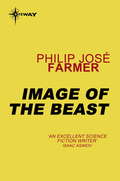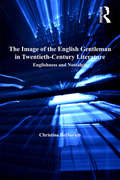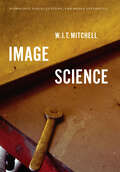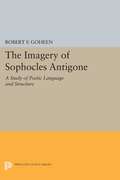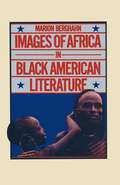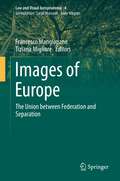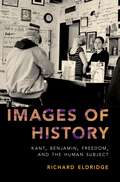- Table View
- List View
The Image of Christ in Russian Literature: Dostoevsky, Tolstoy, Bulgakov, Pasternak (NIU Series in Orthodox Christian Studies)
by John GivensVladimir Nabokov complained about the number of Dostoevsky's characters "sinning their way to Jesus." In truth, Christ is an elusive figure not only in Dostoevsky's novels, but in Russian literature as a whole. The rise of the historical critical method of biblical criticism in the nineteenth century and the growth of secularism it stimulated made an earnest affirmation of Jesus in literature highly problematic. If they affirmed Jesus too directly, writers paradoxically risked diminishing him, either by deploying faith explanations that no longer persuade in an age of skepticism or by reducing Christ to a mere argument in an ideological dispute. The writers at the heart of this study understood that to reimage Christ for their age, they had to make him known through indirect, even negative ways, lest what they say about him be mistaken for cliché, doctrine, or naïve apologetics. The Christology of Dostoevsky, Leo Tolstoy, Mikhail Bulgakov, and Boris Pasternak is thus apophatic because they deploy negative formulations (saying what God is not) in their writings about Jesus. Professions of atheism in Dostoevsky and Tolstoy's non-divine Jesus are but separate negative paths toward truer discernment of Christ. This first study in English of the image of Christ in Russian literature highlights the importance of apophaticism as a theological practice and a literary method in understanding the Russian Christ. It also emphasizes the importance of skepticism in Russian literary attitudes toward Jesus on the part of writers whose private crucibles of doubt produced some of the most provocative and enduring images of Christ in world literature. This important study will appeal to scholars and students of Orthodox Christianity and Russian literature, as well as educated general readers interested in religion and nineteenth-century Russian novels.
The Image of Her: The most surprising thriller you will read this year
by Sonia VeltonFrom the author of Blackberry & Wild Rose comes an extraordinary story of two women who never meet and yet share the closest possible bond.STELLA and CONNIE are strangers, brought together by two traumatic events - cruel twists of fate that happen thousands of miles apart. Stella lives with her mother, a smothering narcissist. When she succumbs to dementia, the pressures on Stella's world intensify, culminating in tragedy. As Stella recovers from a near fatal accident, she feels compelled to share her trauma but she finds talking difficult. In her head she confides in Connie because there's no human being in the world that she feels closer to.Connie is an expat living in Dubai with her partner, Mark, and their two children. On the face of it she wants for nothing and yet ... something about life in this glittering city does not sit well with her. Used to working full time in a career she loves back in England, she struggles to find meaning in the expat life of play-dates and pedicures.Two women set on a collision course. When they finally link up, it will not be in a way that you, or I, or anyone would ever have expected.
The Image of Manhood in Early Modern Literature: Viewing the Male (Contributions to the Study of World Literature)
by Andrew P. WilliamsThe numerous and multifaceted ways in which masculinities emerge and are expressed within cultures prompt a broad ranging examination and reconsideration of what it means to be a man. Within the study of masculinity, the early modern period stands between the Renaissance, when conceptions of manhood were primarily dominated by chivalric and humanistic traditions, and the latter half of the 18th century, which marked the beginnings of modern conceptions of masculine identity. But rather than a transitional period, the early modern era was a key moment in the evolutionary dynamics of masculine representation. Political forces, such as the Puritan revolution, the Restoration, and the shift in power from the courtier class to the growing middle class forced a reconsideration of the masculine ideal in light of the experiences of the masses. At the same time, the emergence of print culture provided a means of transmitting the new masculine ideal, and literature of the period reflected the changing notions of masculinity.The chapters in this volume explore the various strategies used by early modern writers to represent masculinity. Together, the expert contributors offer a broad perspective on the social and political dynamics of early modern masculine identity. Included are chapters on such writers as Thomas Carew, Andrew Marvell, Francis Beaumont and John Fletcher, John Dryden, Daniel Defoe, and Samuel Richardson. Though incorporating a variety of critical approaches, the contributors all explore the inherent anxiety associated with masculinity and its representation. The chapters demonstrate how significant literary texts of the period provided not only idealized images of early modern manhood but also contesting ones. By focusing on the literary, historical, and social dynamics which construct cultural perceptions of masculinity, this volume ultimately illustrates the literary representation of manhood in the early modern period to be a dynamic and evolving process which often challenged Western notions of what it means to be a man.
Image of the Beast (Herald Childe #1)
by Philip Jose FarmerAfter viewing his partner's mutilation in a home movie, a horrified private detective pursues leads in the most disgusting case of his career. His investigation plunges him into a nightmare of sexual brutality and supernatural bestiality. It is a journey he - and you - will never forget.
The Image of the English Gentleman in Twentieth-Century Literature: Englishness and Nostalgia
by Christine BerberichStudies of the English gentleman have tended to focus mainly on the nineteenth century, encouraging the implicit assumption that this influential literary trope has less resonance for twentieth-century literature and culture. Christine Berberich challenges this notion by showing that the English gentleman has proven to be a remarkably adaptable and relevant ideal that continues to influence not only literature but other forms of representation, including the media and advertising industries. Focusing on Siegfried Sassoon, Anthony Powell, Evelyn Waugh and Kazuo Ishiguro, whose presentations of the gentlemanly ideal are analysed in their specific cultural, historical, and sociological contexts, Berberich pays particular attention to the role of nostalgia and its relationship to 'Englishness'. Though 'Englishness' and by extension the English gentleman continue to be linked to depictions of England as the green and pleasant land of imagined bygone days, Berberich counterbalances this perception by showing that the figure of the English gentleman is the medium through which these authors and many of their contemporaries critique the shifting mores of contemporary society. Twentieth-century depictions of the gentleman thus have much to tell us about rapidly changing conceptions of national, class, and gender identity.
The Image of the English Gentleman in Twentieth-Century Literature: Englishness and Nostalgia
by Christine BerberichStudies of the English gentleman have tended to focus mainly on the nineteenth century, encouraging the implicit assumption that this influential literary trope has less resonance for twentieth-century literature and culture. Christine Berberich challenges this notion by showing that the English gentleman has proven to be a remarkably adaptable and relevant ideal that continues to influence not only literature but other forms of representation, including the media and advertising industries. Focusing on Siegfried Sassoon, Anthony Powell, Evelyn Waugh and Kazuo Ishiguro, whose presentations of the gentlemanly ideal are analysed in their specific cultural, historical, and sociological contexts, Berberich pays particular attention to the role of nostalgia and its relationship to 'Englishness'. Though 'Englishness' and by extension the English gentleman continue to be linked to depictions of England as the green and pleasant land of imagined bygone days, Berberich counterbalances this perception by showing that the figure of the English gentleman is the medium through which these authors and many of their contemporaries critique the shifting mores of contemporary society. Twentieth-century depictions of the gentleman thus have much to tell us about rapidly changing conceptions of national, class, and gender identity.
The Image of the Puppet in Italian Theater, Literature and Film
by Federico PacchioniWith the advancement of cybernetics, avatars, animation, and virtual reality, a thorough understanding of how the puppet metaphor originates from specific theatrical practices and media is especially relevant today. This book identifies and interprets the aesthetic and cultural significance of the different traditions of the Italian puppet theater in the broader Italian culture and beyond. Grounded in the often-overlooked history of the evolution of several Italian puppetry traditions – the central and northern Italian stringed marionettes, the Sicilian pupi, the glove puppets of the Po Valley, and the Neapolitan Pulcinella – this study examines a broad spectrum of visual, cinematic, literary, and digital texts representative of the functions and themes of the puppet. A systematic analysis of the meanings ascribed to the idea and image of the puppet provides a unique vantage point to observe the perseverance and transformation of its deeper associations, linking premodern, modern, and contemporary contexts.
The Image of Women in Contemporary Soviet Fiction: Selected Short Stories from the USSR
by transThe stories in this collection portray Soviet women of different ages and educational backgrounds at home and at work, in cities and villages. Their themes reflect the social changes in Soviet life in the past 20 years, and are aimed to stimulate inquiry into social and feminist issues.
An Image Of You (Mills And Boon Cherish Ser.)
by Liz FieldingAN IMAGE OF YOU The rebel and the artist
The Image of You: I thought I knew you. But you're a liar.
by Adele ParksThe Image of You is the utterly gripping new novel from Adele Parks, author of the No. 1 bestselling ebook, The Stranger In My Home. This story of families, love, deception and secrets is perfect for fans of TV's Doctor Foster, Liar, The Replacement, Liane Moriarty's Big Little Lies and Shari Lapena. 'Brilliant storyline, great characters, very clever, loved it!' B A Paris'Addictive and perceptive' Lucy Atkins'A compelling and gripping story of secrets and lies' Daily ExpressCan you ever trust someone you meet online?Anna and Zoe are twins. Identical in appearance, utterly different in personality, they share a bond so close that nothing - or no one - can rip them apart.Until Anna meets charismatic Nick.Anna is trusting, romantic and hopeful; she thinks Nick is perfect.Zoe is daring, dangerous and extreme; she thinks Nick is a liar.Zoe has seen Anna betrayed by men before. She'll stop at nothing to discover if Nick is as good as he seems. Lies may hurt. But honesty can kill.
Image Science: Iconology, Visual Culture, and Media Aesthetics
by W. J. MitchellAlmost thirty years ago, W. J. T. Mitchell’s Iconology helped launch the interdisciplinary study of visual media, now a central feature of the humanities. Along with his subsequent Picture Theory and What Do Pictures Want?, Mitchell’s now-classic work introduced such ideas as the pictorial turn, the image/picture distinction, the metapicture, and the biopicture. These key concepts imply an approach to images as true objects of investigation—an “image science.” Continuing with this influential line of thought, Image Science gathers Mitchell’s most recent essays on media aesthetics, visual culture, and artistic symbolism. The chapters delve into such topics as the physics and biology of images, digital photography and realism, architecture and new media, and the occupation of space in contemporary popular uprisings. The book looks both backward at the emergence of iconology as a field and forward toward what might be possible if image science can indeed approach pictures the same way that empirical sciences approach natural phenomena. Essential for those involved with any aspect of visual media, Image Science is a brilliant call for a method of studying images that overcomes the “two-culture split” between the natural and human sciences.
Image Science: Iconology, Visual Culture, and Media Aesthetics
by W. J. MitchellAlmost thirty years ago, W. J. T. Mitchell’s Iconology helped launch the interdisciplinary study of visual media, now a central feature of the humanities. Along with his subsequent Picture Theory and What Do Pictures Want?, Mitchell’s now-classic work introduced such ideas as the pictorial turn, the image/picture distinction, the metapicture, and the biopicture. These key concepts imply an approach to images as true objects of investigation—an “image science.” Continuing with this influential line of thought, Image Science gathers Mitchell’s most recent essays on media aesthetics, visual culture, and artistic symbolism. The chapters delve into such topics as the physics and biology of images, digital photography and realism, architecture and new media, and the occupation of space in contemporary popular uprisings. The book looks both backward at the emergence of iconology as a field and forward toward what might be possible if image science can indeed approach pictures the same way that empirical sciences approach natural phenomena. Essential for those involved with any aspect of visual media, Image Science is a brilliant call for a method of studying images that overcomes the “two-culture split” between the natural and human sciences.
Image Science: Iconology, Visual Culture, and Media Aesthetics
by W. J. MitchellAlmost thirty years ago, W. J. T. Mitchell’s Iconology helped launch the interdisciplinary study of visual media, now a central feature of the humanities. Along with his subsequent Picture Theory and What Do Pictures Want?, Mitchell’s now-classic work introduced such ideas as the pictorial turn, the image/picture distinction, the metapicture, and the biopicture. These key concepts imply an approach to images as true objects of investigation—an “image science.” Continuing with this influential line of thought, Image Science gathers Mitchell’s most recent essays on media aesthetics, visual culture, and artistic symbolism. The chapters delve into such topics as the physics and biology of images, digital photography and realism, architecture and new media, and the occupation of space in contemporary popular uprisings. The book looks both backward at the emergence of iconology as a field and forward toward what might be possible if image science can indeed approach pictures the same way that empirical sciences approach natural phenomena. Essential for those involved with any aspect of visual media, Image Science is a brilliant call for a method of studying images that overcomes the “two-culture split” between the natural and human sciences.
Image Science: Iconology, Visual Culture, and Media Aesthetics
by W. J. MitchellAlmost thirty years ago, W. J. T. Mitchell’s Iconology helped launch the interdisciplinary study of visual media, now a central feature of the humanities. Along with his subsequent Picture Theory and What Do Pictures Want?, Mitchell’s now-classic work introduced such ideas as the pictorial turn, the image/picture distinction, the metapicture, and the biopicture. These key concepts imply an approach to images as true objects of investigation—an “image science.” Continuing with this influential line of thought, Image Science gathers Mitchell’s most recent essays on media aesthetics, visual culture, and artistic symbolism. The chapters delve into such topics as the physics and biology of images, digital photography and realism, architecture and new media, and the occupation of space in contemporary popular uprisings. The book looks both backward at the emergence of iconology as a field and forward toward what might be possible if image science can indeed approach pictures the same way that empirical sciences approach natural phenomena. Essential for those involved with any aspect of visual media, Image Science is a brilliant call for a method of studying images that overcomes the “two-culture split” between the natural and human sciences.
Image Science: Iconology, Visual Culture, and Media Aesthetics
by W. J. MitchellAlmost thirty years ago, W. J. T. Mitchell’s Iconology helped launch the interdisciplinary study of visual media, now a central feature of the humanities. Along with his subsequent Picture Theory and What Do Pictures Want?, Mitchell’s now-classic work introduced such ideas as the pictorial turn, the image/picture distinction, the metapicture, and the biopicture. These key concepts imply an approach to images as true objects of investigation—an “image science.” Continuing with this influential line of thought, Image Science gathers Mitchell’s most recent essays on media aesthetics, visual culture, and artistic symbolism. The chapters delve into such topics as the physics and biology of images, digital photography and realism, architecture and new media, and the occupation of space in contemporary popular uprisings. The book looks both backward at the emergence of iconology as a field and forward toward what might be possible if image science can indeed approach pictures the same way that empirical sciences approach natural phenomena. Essential for those involved with any aspect of visual media, Image Science is a brilliant call for a method of studying images that overcomes the “two-culture split” between the natural and human sciences.
Image Science: Iconology, Visual Culture, and Media Aesthetics
by W. J. MitchellAlmost thirty years ago, W. J. T. Mitchell’s Iconology helped launch the interdisciplinary study of visual media, now a central feature of the humanities. Along with his subsequent Picture Theory and What Do Pictures Want?, Mitchell’s now-classic work introduced such ideas as the pictorial turn, the image/picture distinction, the metapicture, and the biopicture. These key concepts imply an approach to images as true objects of investigation—an “image science.” Continuing with this influential line of thought, Image Science gathers Mitchell’s most recent essays on media aesthetics, visual culture, and artistic symbolism. The chapters delve into such topics as the physics and biology of images, digital photography and realism, architecture and new media, and the occupation of space in contemporary popular uprisings. The book looks both backward at the emergence of iconology as a field and forward toward what might be possible if image science can indeed approach pictures the same way that empirical sciences approach natural phenomena. Essential for those involved with any aspect of visual media, Image Science is a brilliant call for a method of studying images that overcomes the “two-culture split” between the natural and human sciences.
Image Science: Iconology, Visual Culture, and Media Aesthetics
by W. J. MitchellAlmost thirty years ago, W. J. T. Mitchell’s Iconology helped launch the interdisciplinary study of visual media, now a central feature of the humanities. Along with his subsequent Picture Theory and What Do Pictures Want?, Mitchell’s now-classic work introduced such ideas as the pictorial turn, the image/picture distinction, the metapicture, and the biopicture. These key concepts imply an approach to images as true objects of investigation—an “image science.” Continuing with this influential line of thought, Image Science gathers Mitchell’s most recent essays on media aesthetics, visual culture, and artistic symbolism. The chapters delve into such topics as the physics and biology of images, digital photography and realism, architecture and new media, and the occupation of space in contemporary popular uprisings. The book looks both backward at the emergence of iconology as a field and forward toward what might be possible if image science can indeed approach pictures the same way that empirical sciences approach natural phenomena. Essential for those involved with any aspect of visual media, Image Science is a brilliant call for a method of studying images that overcomes the “two-culture split” between the natural and human sciences.
An Image to Die For (Sam Dean Thriller #4)
by Mike PhillipsBehind the scenes of television production journalist-turned-investigator, Sam Dean, discovers greed, ugliness and murder. When a TV producer offers journalist Sam Dean the job of tracking down a suspect in the brutal murder of a young woman and her child, he's reluctant to get involved. But when a colleague is stabbed to death on set, it’s clear something bigger is going on. And when threatening anonymous notes start arriving, Sam is forced to dig for the truth… Standing astride 1980s London’s sharp racial divides, An Image to Die For is a crime thriller perfect for fans of S.A. Cosby and Walter Mosley.
Imagery of Sophocles Antigone
by Robert Francis GoheenA systematic investigation of a Greek text, employing the techniques of the "new criticism." The book is a major contribution to the study of Sophocles and of Greek drama.Originally published in 1951.The Princeton Legacy Library uses the latest print-on-demand technology to again make available previously out-of-print books from the distinguished backlist of Princeton University Press. These editions preserve the original texts of these important books while presenting them in durable paperback and hardcover editions. The goal of the Princeton Legacy Library is to vastly increase access to the rich scholarly heritage found in the thousands of books published by Princeton University Press since its founding in 1905.
Images de Jean-Jacques Rousseau de 1912 à 1978 (Oxford University Studies in the Enlightenment #300)
by Tanguy L'aminotL’étude de la réception de Rousseau s’est longtemps cantonnée au XVIIIe siècle, à la Révolution française et au Romantisme. Il semblait qu’au-delà les lecteurs déformaient trop la pensée du philosophe et l’utilisaient à des fins qui lui étaient étrangères. Pourtant le commentaire sur Rousseau n’a jamais été aussi important, riche et varié qu’au XXe siècle où plus de vingt mille livres et articles lui ont été consacrés de par le monde entier et sur tous les sujets que son oeuvre a abordés. Il est essentiellement devenu le fait de l’université à partir de 1950, mais on aurait tort de négliger pour autant le discours extra-universitaire tel qu’il s’est montré avant-guerre ou tel qu’il se montre encore en maintes occasions. La présente étude examine cette réception à travers les trois célébrations de 1912 (bicentenaire de la naissance de Rousseau), 1962 (deux cent cinquantième anniversaire de sa naissance et bicentenairedu Contrat social) et 1978 (bicentenaire de sa mort). Elle montre les enjeux de chaque période et comment, à chaque fois, Rousseau a fait parler ceux qui croyaient le faire parler. L’interprétation de l’oeuvrequi, souvent, plonge l’étudiant dans une attitude contemplative a longtemps fait croire au caractère neutre de la critique. Celle-ci, Wolfgang Iser l’a bien montré, ne l’est pourtant jamais et exprime les préjugés et les limites de son temps, aujourd’hui comme hier. Le travail sur la réception de Rousseau illustre bien cette utilisation que chaque époque fait de sa pensée.
Images of Europe: The Union between Federation and Separation (Law and Visual Jurisprudence #4)
by Francesco Mangiapane Tiziana MiglioreThis book deals with the fundamental semantics of images of Europe, which consist of valences, mirror beliefs and affectivities. This is why it relaunches the importance of the European discourse in its symbolic dimension. As such, it explores the many images of Europe, or rather the many images through which European discourse is actually constituted in daily life, in search of their enunciative responsibility in today’s world for determining the current “State of the Union”. The identity of the European continent is based on a millenary tension between universalism and particularism: images of Europe have in fact been alternately inspired, over the centuries, by a model of homogeneity – Roman and Carolingian imperial disposition – on the one hand, and by a model of fragmentation – a Europe of city-states, municipalities, regions and small fatherlands – on the other. In the European Union, a political and economic organism, this issue has recently been amplified to the point that it has reentered public debate, and political parties that are only recognizable for being Europeanists or anti-Europeanists are now ubiquitous. In this regard, one major bone of contention is how to portray the quintessential aspects of the European territory, which are either interpreted as “thresholds” to be overcome in the name of a model of United Europe – “integral totality” – or are instead regarded as insurmountable obstacles for a Europe that is irreparably and perhaps, according to anti-Europeanists, fortunately fragmented – “partitive totality”. Further, this is to be done without excluding the possibility of contradictory and complementary solutions to these binary visions. In this context the book analyzes various texts in order to obtain a more precise picture of the clash, reveal its semiotic forms, and by doing so, identify a way out of the crisis.
Images of History: Kant, Benjamin, Freedom, and the Human Subject
by Richard EldridgeDeveloping work in the theories of action and explanation, Eldridge argues that moral and political philosophers require accounts of what is historically possible, while historians require rough philosophical understandings of ideals that merit reasonable endorsement. Both Immanuel Kant and Walter Benjamin recognize this fact. Each sees a special place for religious consciousness and critical practice in the articulation and revision of ideals that are to have cultural effect, but they differ sharply in the forms of religious-philosophical understanding, cultural criticism, and political practice that they favor. Kant defends a liberal, reformist, Protestant stance, emphasizing the importance of liberty, individual rights, and democratic institutions. His fullest picture of movement toward a moral culture appears in Religion within the Bounds of Mere Reason, where he describes conjecturally the emergence of an ethical commonwealth. Benjamin defends a politics of improvisatory alertness and consciousness-raising that is suspicious of progress and liberal reform. He practices a form of modernist, materialist criticism that is strongly rooted in his encounters with Kant, Hölderlin, and Goethe. His fullest, finished picture of this critical practice appears in One-Way Street, where he traces the continuing force of unsatisfied desires. By drawing on both Kant and Benjamin, Eldridge hopes to avoid both moralism (standing on sharply specified normative commitments at all costs) and waywardness (rejecting all settled commitments). And in doing so, he seeks to make better sense of the commitment-forming, commitment-revising, anxious, reflective and sometimes grownup acculturated human subjects we are.
Images of History: Kant, Benjamin, Freedom, and the Human Subject
by Richard EldridgeDeveloping work in the theories of action and explanation, Eldridge argues that moral and political philosophers require accounts of what is historically possible, while historians require rough philosophical understandings of ideals that merit reasonable endorsement. Both Immanuel Kant and Walter Benjamin recognize this fact. Each sees a special place for religious consciousness and critical practice in the articulation and revision of ideals that are to have cultural effect, but they differ sharply in the forms of religious-philosophical understanding, cultural criticism, and political practice that they favor. Kant defends a liberal, reformist, Protestant stance, emphasizing the importance of liberty, individual rights, and democratic institutions. His fullest picture of movement toward a moral culture appears in Religion within the Bounds of Mere Reason, where he describes conjecturally the emergence of an ethical commonwealth. Benjamin defends a politics of improvisatory alertness and consciousness-raising that is suspicious of progress and liberal reform. He practices a form of modernist, materialist criticism that is strongly rooted in his encounters with Kant, Hölderlin, and Goethe. His fullest, finished picture of this critical practice appears in One-Way Street, where he traces the continuing force of unsatisfied desires. By drawing on both Kant and Benjamin, Eldridge hopes to avoid both moralism (standing on sharply specified normative commitments at all costs) and waywardness (rejecting all settled commitments). And in doing so, he seeks to make better sense of the commitment-forming, commitment-revising, anxious, reflective and sometimes grownup acculturated human subjects we are.



